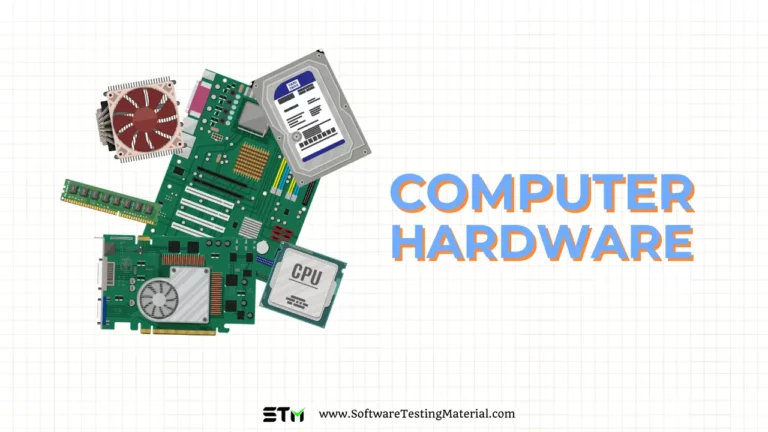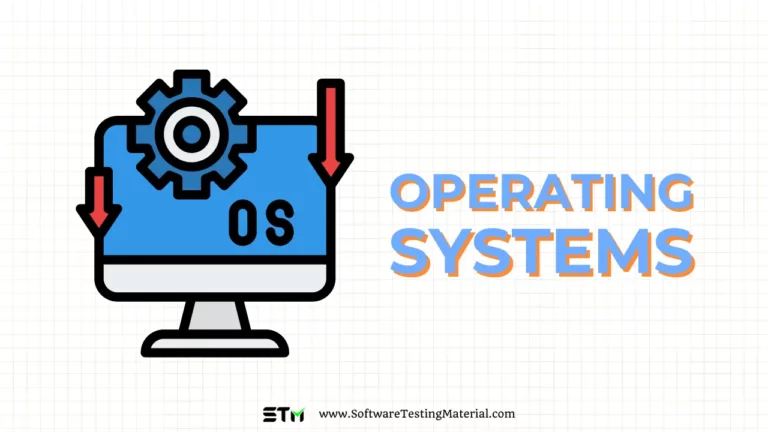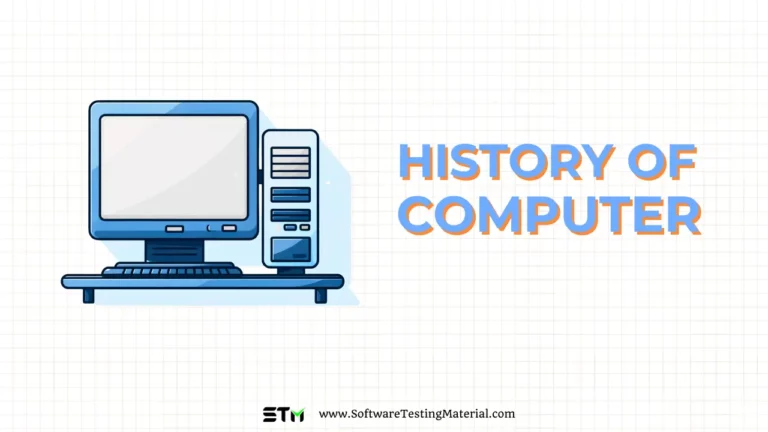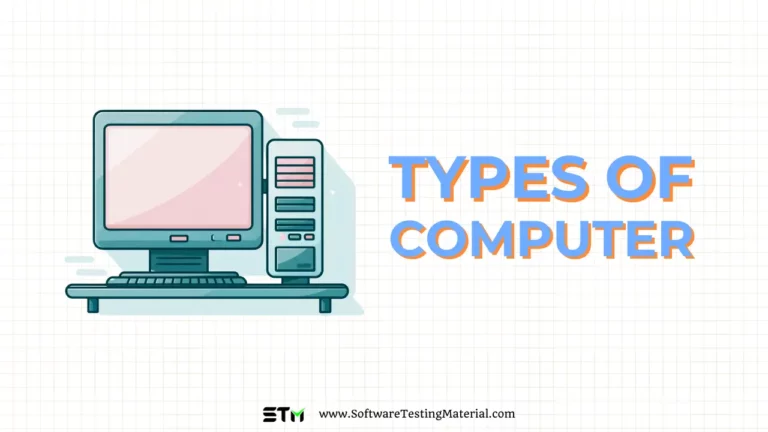Basics of Computer Network: Explained In Detail
Understanding the basics of computer network is essential in today’s interconnected world. Whether you’re setting up a home network, managing an enterprise-level IT infrastructure, or simply curious about how devices communicate, a solid grasp of networking fundamentals is vital. This guide will walk you through key concepts, including types of networks, network topologies, communication protocols, and essential hardware components. By the end of this article, you’ll have a clear understanding of how networks function and how they empower seamless digital communication. Dive in to unlock the power of connectivity and elevate your networking knowledge.
Must read: Computer Fundamentals Tutorial

What is a Computer Network?
A computer network is a collection of interconnected devices that communicate with each other to share resources, data, and applications. These networks enable devices such as computers, servers, and printers to work together, providing users with the ability to access and share information efficiently.
How Does a Computer Network Work?
A computer network works by connecting devices through various types of communication channels, which could be wired, like Ethernet cables, or wireless, like Wi-Fi. These channels allow data to be transmitted between devices using a set of rules known as protocols. The most commonly used protocol is the Internet Protocol (IP), which ensures data is sent and received accurately.
Basic Terminologies of Computer Networks
- Node: Any device connected to the network, such as computers, printers, and servers.
- Link: The physical or logical connection between two nodes.
- Bandwidth: The maximum data transfer capacity of a network.
- Latency: The time it takes for data to travel from the source to the destination.
- IP Address: A unique identifier for each device on a network.
- Router: A device that forwards data packets between computer networks.
Types of Enterprise Computer Networks
Enterprise computer networks can be broadly classified into three main types: Local Area Network (LAN), Metropolitan Area Network (MAN), and Wide Area Network (WAN). Each type has its own unique characteristics, features, and benefits that make it suitable for different organizational needs.
Local Area Network (LAN)
A Local Area Network (LAN) is a network that connects computers and devices within a limited geographical area such as a single building, office, or campus. LANs are typically used to share resources like printers, files, and internet connections among multiple devices.
Features of LAN:
- High Data Transfer Speed: LANs offer high data transfer rates, typically ranging from 100 Mbps to 10 Gbps.
- Low Latency: Due to the close proximity of connected devices, LANs exhibit low latency which means data travels quickly between nodes.
- Limited Range: They generally cover small geographic areas, making them ideal for localized networking needs.
- Wired or Wireless Connectivity: LANs can function using Ethernet cables (wired) or Wi-Fi (wireless) connections.
- Centralized Administration: Easier to administer and manage resources through local servers.
Benefits of LAN:
- Resource Sharing: Enables efficient sharing of resources like printers, files, and applications.
- Cost-Effective: Devices on a LAN can share software licenses and reduce overall costs.
- Enhanced Security: Localized data handling allows better control over security measures.
- Reliability: Reduced network downtime due to the simplicity of the network infrastructure.
Metropolitan Area Network (MAN)
A Metropolitan Area Network (MAN) spans a larger geographical area than a LAN, covering a city or a large campus. MANs are designed to extend and connect multiple LANs within a specific region.
Features of MAN:
- Moderate Range: Connects multiple LANs over distances up to 50 kilometers.
- High-Capacity Backbone: Utilizes high-capacity transmission media like fiber optics.
- Enhanced Performance: Provides higher data transfer speeds compared to WAN.
- Integration: Can integrate with other MANs and WANs for broader connectivity.
Benefits of MAN:
- Scalability: Easily expandable to accommodate more users and devices.
- Cost Efficiency: Reduces the need for expensive long-distance communications by localizing data traffic.
- Centralized Data Management: Facilitates centralized data management and backup processes.
- High Speed: Provides faster data transfer rates than WANs over the covered area.
Wide Area Network (WAN)
A Wide Area Network (WAN) covers a broad geographic area, often a country or even globally. WANs are designed to connect multiple LANs and MANs, enabling long-distance communication and resource sharing.
Features of WAN:
- Extensive Coverage: Can connect devices and networks across vast distances.
- Diverse Connectivity: Utilizes various transmission media, including satellites, leased lines, and public networks.
- Complex Infrastructure: Involves a more complex and hierarchical network structure.
- Lower Data Transfer Speed: Generally offers lower data transfer speeds compared to LANs and MANs due to longer distances and multiple traversed networks.
Benefits of WAN:
- Global Reach: Facilitates communication and resource sharing across widespread locations.
- Improved Collaboration: Enables organizations with multiple branches to collaborate seamlessly.
- Disaster Recovery: Enhances disaster recovery capabilities by connecting data centers across various locations.
- Resource Accessibility: Allows access to centralized resources and applications from remote locations.
Cloud Networks
Cloud networks leverage cloud computing technologies to provide scalable, flexible, and cost-efficient networking solutions. Unlike traditional networks that rely heavily on physical hardware, cloud networks utilize virtual resources managed by cloud service providers. This shift enables businesses to rapidly deploy, manage, and scale their network infrastructure as needed.
Features of Cloud Networks:
- Scalability: Easily scalable to meet the dynamic demands of business operations without significant investment in physical hardware.
- Global Accessibility: Provides access to network resources and applications from anywhere with an internet connection.
- Elasticity: Automatically adjusts resources based on current workload demands, ensuring optimal performance.
- Reduced Hardware Dependency: Minimizes dependency on physical infrastructure by utilizing virtualized environments.
- High Availability: Designed to provide high availability with redundant resources and failover mechanisms to minimize downtime.
Benefits of Cloud Networks:
- Cost Efficiency: Reduces capital expenditures on physical infrastructure and lowers maintenance costs through a pay-as-you-go pricing model.
- Enhanced Flexibility: Offers flexible resource allocation, allowing businesses to adapt quickly to changing requirements.
- Improved Collaboration: Facilitates seamless collaboration across geographically dispersed teams by centralizing resources and applications in the cloud.
- Disaster Recovery: Strengthens disaster recovery capabilities with data replication and backup solutions across multiple data centers.
- Simplified Management: Allows for centralized management and monitoring of network resources through cloud management platforms, simplifying administrative tasks.
- Security: Often includes advanced security measures provided by cloud service providers to protect data and network integrity.
Each type of enterprise network serves specific needs based on the size, location, and requirements of an organization, providing tailored solutions to optimize connectivity and resource sharing.
Types of Computer Network Architecture
Computer network architecture can be broadly classified into two main types: Client-Server Architecture and Peer-to-Peer (P2P) Architecture.
Client-Server Architecture
In client-server architecture, the network is divided into two types of entities: clients and servers. The server is a powerful computer that provides resources or services, while the client is a user’s device that requests and uses those resources.
Features of Client-Server Architecture
- Centralized Control: The server manages network resources and client devices, providing a centralized point of control.
- Scalability: The architecture can be scaled by adding more servers or upgrading existing servers to handle increased client demands.
- Security: Enhanced security measures can be implemented, including user authentication and data encryption, controlled centrally by the server.
- Reliability: Servers are often equipped with redundant components and backup systems, ensuring high availability and reliability.
Benefits of Client-Server Architecture
- Efficient Resource Management: Centralized control allows for the efficient allocation and management of resources across the network.
- Easier Maintenance: Administrators can perform updates, backups, and maintenance tasks on the server rather than individual client devices.
- Improved Security: With all data stored and managed on the server, it is easier to enforce security policies and protect against unauthorized access.
- Better Performance: High-performance servers can handle complex tasks, freeing up client devices to focus on specific user activities without being overburdened.
Peer-to-Peer (P2P) Architecture
In peer-to-peer architecture, each device on the network, referred to as a peer, has equal status and can act as both a client and a server. This decentralized approach allows peers to share resources directly with each other without the need for a central server.
Features of Peer-to-Peer Architecture
- Decentralized Network: There is no central server; each peer has equivalent capabilities and responsibilities.
- Direct Communication: Peers communicate directly with each other to share resources, data, and services.
- Flexibility: The network can easily adapt to new peers joining or existing peers leaving without significant disruption.
- Reduced Dependency: The network does not rely on a central point of failure, increasing resilience and fault tolerance.
Benefits of Peer-to-Peer Architecture
- Cost-Effective: There is no need for a dedicated server, reducing hardware and maintenance costs.
- Scalability: The network can expand as more peers join, naturally increasing its capacity and capability.
- Redundancy: The decentralized nature means that the failure of one or more peers has a minimal impact on the overall network.
- Resource Sharing: Peers can share their resources, such as storage space and processing power, leading to efficient utilization of available resources.
Both client-server and peer-to-peer architectures have their unique advantages and are chosen based on the specific needs and requirements of the network. Understanding their features and benefits helps in designing effective network solutions tailored to organizational or individual objectives.
OSI Model
The Open Systems Interconnection (OSI) model is a conceptual framework used to understand and standardize the functions of a telecommunication or computing system without regard to its underlying internal structure and technology. The model is divided into seven layers, each specifying particular network functions and protocols.
- Physical Layer: This is the lowest layer, dealing with the physical connection between devices, including cables, switches, and other hardware. It handles the transmission and reception of raw data streams over a physical medium.
- Data Link Layer: Responsible for node-to-node data transfer and error detection and correction. It ensures that data transferred across the physical layer is reliable and error-free.
- Network Layer: Deals with routing, forwarding, and addressing data packets so they can travel across intermediate routers to reach their final destination. The best-known protocol in this layer is the Internet Protocol (IP).
- Transport Layer: Ensures complete data transfer and reliability between host systems. This layer includes error recovery and flow control mechanisms. Commonly used protocols here are TCP (Transmission Control Protocol) and UDP (User Datagram Protocol).
- Session Layer: Manages sessions or connections between applications. It controls the dialogues (connections) between computers, managing them and terminating them as necessary.
- Presentation Layer: Responsible for translating, encrypting, and compressing data. This layer ensures that data is in a readable format for the application layer. It acts as a translator between the network and the application.
- Application Layer: The topmost layer, closest to the end-user. It provides networking services directly to the end-user or application processes. Protocols such as HTTP, FTP, SMTP, and DNS operate at this layer.
Understanding the OSI model is crucial for network professionals as it facilitates clearer troubleshooting and network design by segmenting complex networking processes into manageable, well-defined layers.
Network Devices
Network devices are critical components that facilitate communication and data exchange across a network. They come in various forms, each serving a unique purpose to ensure that the network operates smoothly and efficiently. Below are some of the most common types of network devices:
1. Router
A router is a device that forwards data packets between computer networks. It is responsible for directing traffic on the internet by determining the best path for data to travel. Routers operate at the network layer (Layer 3) of the OSI model and use IP addresses to make routing decisions. They can connect different network types, such as wired and wireless networks, and include built-in security features like firewalls and VPN support.
2. Switch
A switch is used to connect multiple devices within the same network, allowing them to communicate with each other. Operating at the data link layer (Layer 2) of the OSI model, switches use MAC addresses to forward data to the correct destination. They help to reduce network congestion by creating separate collision domains for each connected device, thus improving overall network performance.
3. Hub
A hub acts as a basic form of a switch but with more limited capabilities. It broadcasts incoming data to all connected devices, regardless of the intended recipient. Operating at the physical layer (Layer 1) of the OSI model, hubs are simpler and less expensive than switches but are less efficient and can lead to network collisions and excessive traffic.
4. Modem
A modem (modulator-demodulator) is a device that converts digital data from a computer into analog signals suitable for transmission over telephone lines or cable systems and vice versa. Modems enable internet connectivity by translating the data sent by an Internet Service Provider (ISP) into a format that can be understood by end-user devices.
5. Bridge
A bridge is a network device that connects multiple network segments at the data link layer (Layer 2) of the OSI model. It is used to reduce network congestion by dividing large networks into smaller, more manageable segments, thus improving overall network performance. Bridges operate by filtering and forwarding data based on MAC addresses, ensuring that packets are only sent to the segment where the destination device is located. This process helps in isolating collision domains and reducing broadcast traffic, making bridges an essential tool in creating efficient and scalable networks.
6. Access Point
An access point (AP) provides wireless devices with a means to connect to a wired network using Wi-Fi. Operating primarily at the data link layer (Layer 2), it acts as a bridge between wired and wireless networks, extending the reach of the network. Access points are often used to increase the coverage area of a Wi-Fi network, providing seamless connectivity for mobile devices.
7. Firewall
A firewall is a network security device that monitors and controls incoming and outgoing network traffic based on predetermined security rules. It acts as a barrier between a trusted, secure internal network and an untrusted external network, such as the internet. Firewalls can be hardware-based, software-based, or a combination of both, and they operate at various layers of the OSI model depending on their complexity and design.
8. Network Interface Card (NIC)
A Network Interface Card (NIC) is a hardware component that provides a computer with the ability to connect to a network. It operates at both the physical layer (Layer 1) and the data link layer (Layer 2) of the OSI model. Each NIC has a unique MAC address, which it uses to communicate on the network. NICs can be wired, using Ethernet cables, or wireless, using Wi-Fi technology.
Understanding the roles and functions of various network devices is essential for designing and maintaining an efficient and secure network. Each device contributes to the network’s overall performance, scalability, and reliability, ensuring seamless data communication and connectivity across the network infrastructure.
Network Topology
Network topology refers to the arrangement of various elements (links, nodes, etc.) in a computer network.
- Star Topology: All nodes are connected to a central hub. Simple to set up and manage.
- Bus Topology: All nodes share a common communication line. Cost-effective but limited by the bus length.
- Ring Topology: Each node is connected to two other nodes, forming a ring. Provides orderly network access but can be difficult to troubleshoot.
- Mesh Topology: Every node is connected to every other node. Highly reliable and robust but expensive to implement.
Understanding these basics helps in setting up a computer network that meets specific needs, ensuring efficient communication and resource sharing.
Conclusion
In conclusion, a fundamental understanding of computer networks is crucial for anyone involved in the field of information technology. From the roles of essential network devices like routers, switches, and Network Interface Cards (NICs) to the various network topologies such as star, bus, ring, and mesh, each component and configuration plays a vital role in ensuring effective communication and resource sharing. By comprehending these elements, one can design, implement, and maintain a network that is not only efficient but also scalable and reliable. As technology continues to evolve, staying informed about network fundamentals will empower individuals and organizations to adapt and thrive in an increasingly interconnected world.






